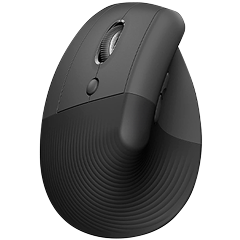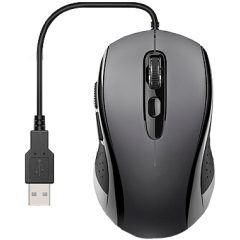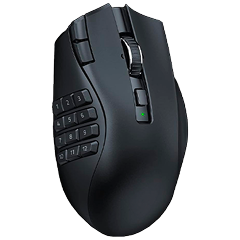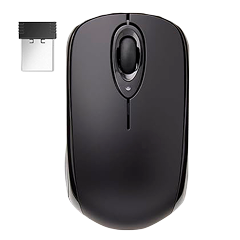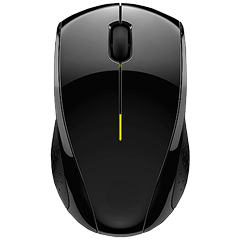Ya sea que acabes de montar tu setup soñado o de estrenar un potente portátil gaming, ese ratón básico que viene de fábrica no va a estar a la altura cuando llegue el momento de jugar en serio. No todos los ratones son iguales y, en el caso de los ratones gaming, la elección puede ser decisiva a la hora de jugar a determinados tipos de juego.
Si bien los ratones específicos para un tipo concreto de juego son estupendos cuando solo juegas a ese género, la mayoría de usuarios alternamos entre distintos juegos. Por ello, lo mejor son los ratones de gaming polivalentes, diseñados para lograr un equilibrio entre rendimiento, comodidad y flexibilidad.
Con tantísimas marcas y modelos, la elección no es nada fácil y puede agobiarte no saber ni por dónde empezar. Para ayudarte, he redactado esta guía que incluye todo lo que necesitas saber a la hora de elegir el ratón gaming perfecto para ti.
Repasaremos las especificaciones clave más importantes, explicaremos qué características son realmente las más útiles (y cuáles no) y, en última instancia, te ayudaremos a decidir a qué dar prioridad según tu estilo de juego.
¿Qué hace que un ratón gaming sea un buen ratón para jugar?
Comencemos por lo fundamental: ¿qué es un ratón gaming y hasta qué punto resulta necesario?
Aparte de unas luces RGB llamativas, a simple vista un ratón gaming probablemente no parezca muy distinto de cualquier otro. En general, tiene la misma forma, las funciones de apuntar y hacer clic y probablemente se conecte mediante USB o a través de un receptor inalámbrico. Vamos, lo de siempre.
No obstante, si miras un poco más allá de esa carcasa de plástico, descubrirás algo muy distinto, ya que estos ratones están diseñados para la velocidad, la precisión y la durabilidad de una forma que los ratones estándar no ofrecen.
Las principales diferencias se reducen a la capacidad de respuesta, la precisión y el detalle. Los ratones gaming incorporan sensores de alto rendimiento que realizan un seguimiento más preciso y uniforme, incluso cuando mueves el ratón de un lado a otro de la mesa en un arrebato de pánico en el último segundo. También ofrecen tasas de sondeo mucho más rápidas, lo que significa que tus acciones se envían a tu ordenador con más frecuencia y que todo sea más rápido. Tampoco olvidemos la importancia de una latencia baja: un par de milisegundos entre que pulsas el botón y que el juego responda puede no parecer gran cosa, pero cuando luchas por la victoria marcan la diferencia.
Más allá del rendimiento puro, está la flexibilidad. Un buen ratón gaming te permitirá ajustar todo a tu gusto, desde la sensibilidad DPI hasta las funciones de los botones, algunos incluso tienen memoria integrada para almacenar perfiles específicos para distintos juegos.
Especificaciones que debe tener un ratón gaming
Empecemos por los detalles más importantes, pero también los más confusos: las especificaciones técnicas en bruto. Cuando se trata del rendimiento de un ratón, la calidad del sensor lo es todo y eso se define por unos pocos detalles principales. En las páginas de cada producto, las marcas suelen presentar una avalancha de cifras que pueden impedirte diferenciar cuáles son las más relevantes. Desglosemos las especificaciones fundamentales y su importancia al usar ratones gaming.
DPI
DPI (Dot Per Inch) o PPP (Puntos Por Pulgada), se considera a menudo la métrica clave de la sensibilidad de un ratón. Determina la distancia a la que se desplaza el cursor en la pantalla en función del movimiento del ratón sobre la superficie.
Algunos modelos anuncian DPI de 20.000 o más, pero en la práctica este dato es más publicitario que funcional, pues la mayoría de los jugadores se mueve en el rango de los 800 y 1600. Lo que realmente importa y lo que valoramos muy positivamente es la capacidad de ajustar con precisión la configuración de DPI de un ratón gaming.
Un ratón gaming versátil debe ofrecer la posibilidad de ajustar el DPI en incrementos precisos, pero es aún mejor si permite modificar este parámetro de manera inmediata.
Conviene recordar que la configuración de DPI es subjetiva: la elección óptima varía según el tamaño de la alfombrilla, la resolución de la pantalla y el estilo de juego. Si juegas a FPS, el eDPI (DPI × sensibilidad del juego) es la medida que de verdad importa en el rendimiento.
Tasa de sondeo o Polling rate
Mide la frecuencia con la que el ratón informa de su posición al ordenador y normalmente se muestra en hercios. La tasa de sondeo de 1.000 Hz (significa que se actualiza cada milisegundo) es ahora lo estándar en la mayoría de los ratones gaming y ofrece una capacidad de respuesta más que suficiente para la mayoría de los usuarios.
Esta tasa es la que buscamos, ya que debería valer para todas las partidas. Verás que algunos modelos de gama alta llegan a los 2.000 o incluso a los 8.000 Hz, pero son cifras muy altas que no son las más adecuadas para todo tipo de jugadores.
Velocidad de seguimiento
Se mide en IPS (pulgadas por segundo) e indica la velocidad a la que se puede mover el ratón antes de empezar a perder precisión. Cuanto mayor sea el IPS, mejor podrá seguir los movimientos rápidos sin dar sensación de vibración o inestabilidad.
Para los juegos en general, todo lo que pase de 300 IPS está muy bien y más de 500 es ya lo top. Si también tiene un buen valor de G-force (la máxima aceleración que aguanta el sensor), te aseguras de que los movimientos rápidos no harán que el ratón pierda el control ni se salten clics.
Aceleración
Se trata de una especificación más técnica que suele pasar desapercibida y que, en realidad, gran parte de los jugadores podría ignorar sin que ello suponga un impacto significativo en sus partidas. La aceleración no se nota tanto, pero es clave, sobre todo en cómo se siente el ratón en partidas intensas y de ritmo rápido.
Medido en Gs (como la fuerza gravitatoria), el índice de aceleración indica la capacidad del ratón para soportar movimientos bruscos, como apuntar rápidamente de un enemigo a otro o dar un giro de 180 grados cuando oyes pasos detrás de ti.
Para jugar en general, con más de 30G vas sobrado, solo llegarás a ese tope si usas una sensibilidad muy baja y haces movimientos grandes y rápidos.
Botones adicionales y personalización
Una característica que se ve a menudo en los ratones gaming mucho más que en los tradicionales es la incorporación de botones programables adicionales. Unos cuantos botones adicionales pueden hacer que un ratón sea más versátil, pero hay una delgada línea entre lo funcional y lo exagerado cuando no son absolutamente necesarios. Siempre vienen bien los botones adicionales, pero tener demasiados puede empeorar tu experiencia, así que no siempre conviene el ratón con el mayor número de botones. Para la mayoría de los jugadores suelen ser más que suficientes entre 2 y 5 botones programables repartidos por el ratón.
Estos botones adicionales suelen estar en el lateral del ratón, cerca de donde descansa el pulgar y resultan muy prácticos. Ya sea para lanzar granadas, asignar el push-to-talk o tener acceso rápido al inventario, estos botones pueden mejorar la jugabilidad en distintos juegos y también aportar un beneficio ergonómico. Por otro lado, aunque es una preferencia personal, yo recomendaría evitar los ratones con teclado numérico completo en el lateral a menos que te gusten mucho los juegos de estilo MMO. Al final, esos diseños pueden resultar más incómodos y fuera de su nicho acaban distrayendo más que ayudando.
El software de un ratón también puede ser un plus y su calidad variará de una marca a otra. Te servirá para volver a vincular botones, ajustar algunas de las métricas del sensor de las que hemos hablado antes y crear perfiles para distintos juegos que te permitan ajustar rápidamente una serie de parámetros a la vez. Ciertas marcas destacan en este aspecto al ofrecer interfaces intuitivas, sincronización en la nube y mayores integraciones o compatibilidad con macros más allá de simples asignaciones; por ello, conviene consultar reseñas que evalúen si la experiencia con el software resulta fluida o problemática.
Forma y ergonomía
Independientemente del tipo de juego, la ergonomía es prioritaria y la comodidad indispensable. Un ratón que te canse la mano o que no se adapte a tu estilo de agarre te frenará en todas las partidas e incluso podría repercutir a largo plazo en tu salud. Puede parecer algo simple, pero antes de sumergirse en las especificaciones de los sensores y la compatibilidad con las aplicaciones, conviene averiguar primero qué forma y tamaño se adaptan mejor a ti.
El estilo de agarre juega un papel importante y es aquí por donde deberías empezar. Si agarras el ratón con la palma de la mano (apoyado en la mano y los dedos estirados), busca uno un poco más grande, con una forma ergonómica y una curva más pronunciada.
Si usas agarre en garra o con la punta de los dedos (agarre ligero y dedos curvados), lo normal es que te gusten los ratones pequeños y ligeros, fáciles de mover rápido. El tamaño de la mano también importa, ya que un ratón demasiado pequeño o voluminoso puede provocarte tensión durante partidas largas.
Para el gaming en general, las principales marcas ya han dado con una forma neutra sólida que funciona bien en casi cualquier caso, es habitual encontrarla en ratones gaming cuyos nombres no incorporan especificaciones adicionales. Cuando no se especifica un género o rasgo particular, lo habitual es que presente un diseño neutro, sin esculpidos ni inclinaciones pronunciadas.
Comprueba también el peso del ratón. Para la mayoría de la gente, entre 70 g y 100 g suele haber un buen equilibrio entre agilidad y estabilidad. Los ratones inalámbricos casi siempre son más pesados por la batería interna, al igual que los específicos de agarre con la palma de la mano, simplemente porque son más grandes. Sin embargo, hay opciones ultraligeras, como algunos ratones con cable que pesan solo 60 gramos.
Ratón con cable o inalámbrico: ¿cuál es mejor?
Tal vez no te valga de mucho mi respuesta al principio, pero lo cierto es que ninguno de los dos es mejor, no hay un claro ganador en este sentido.
En el gaming, el debate entre inalámbrico y con cable solía ser obvio: los ratones con cable eran más sensibles y fiables, justo lo que hacía falta para jugar. Sin embargo, las cosas están empezando a cambiar y la diferencia se ha reducido drásticamente.
En la actualidad, los ratones gaming inalámbricos de gama alta igualan a los modelos con cable en parámetros como latencia y precisión, constituyendo una alternativa válida excepto quizá para los jugadores profesionales de élite. Todo se reduce a la preferencia personal y al tipo de juego, por eso no valoramos peor un ratón por ser de cable, ni mejor por ser inalámbrico.
Los ratones inalámbricos tienen ventajas evidentes en cuanto a movimiento y orden en el escritorio. No hay cables que se enganchen, por lo que la experiencia general es más fluida y, admitámoslo, ya tienes suficientes cables de los cuales preocuparte en tu setup.
La duración de la batería también ha mejorado notablemente, ya que muchos ratones gaming duran una semana o más con una sola carga y se cargan tan rápido que casi ni se nota. Ciertos modelos incluso permiten la carga inalámbrica a través de alfombrillas específicas o incorporan estaciones y soportes de carga. Para un ratón gaming inalámbrico clásico, esperaríamos un mínimo de 50 horas de juego con una sola carga para considerarlo bueno, aunque valoramos mucho más cuando llega a las tres cifras.
Dicho esto, los ratones con cable siguen teniendo un papel importante en el mundo del gaming y continúan siendo la opción preferida en los e-sports y entre los profesionales del sector. Aunque la diferencia ya no es tan grande, los ratones gaming con cable seguirán siendo capaces de ofrecer la máxima capacidad de respuesta y fiabilidad. Al fin y al cabo, como no usan señal inalámbrica, no tendrás que preocuparte de interferencias.
En términos generales, resultan más económicos o, en su defecto, priorizan una mayor inversión en el sensor frente a la tecnología inalámbrica y las baterías de los modelos básicos y de gama media. Al no tener batería tampoco hay que preocuparse por los niveles de carga o por perder la conexión a mitad de partida, un problema al que todos nos hemos enfrentado alguna vez. También suelen ser más ligeros, ya que gran parte del peso suele deberse a la batería interna.
El mejor ratón gaming es el que se adapta a ti
Ante la variedad de modelos y marcas de ratones gaming, el ideal es aquel que se ajusta a tus propias necesidades, no hay una respuesta universal. Aquí es donde destacan la flexibilidad, la personalización y las funciones adaptables y es algo a lo que damos valor al realizar las pruebas.
Si eres de los que juegan a todo un poco, te merece la pena invertir en un buen ratón gaming polivalente, pero no hace falta obsesionarse con tener todas las specs al máximo. No hace falta que sea el más ligero, el más llamativo o el que ofrezca las cifras más altas en datos brutos, sino que te resulte cómodo, que responda de forma constante al nivel de control que tienes y se adapte a tus hábitos.
Concéntrate primero en la comodidad y la forma y luego en preferencias personales, como el peso, el rendimiento del sensor y la disposición de los botones. A partir de ahí, se trata simplemente de encontrar un modelo que equilibre esas prioridades dentro de tu presupuesto.


